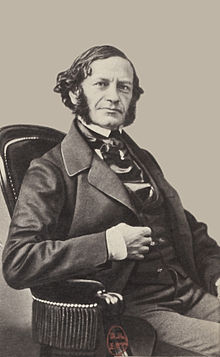Henri heart


Henri Herz ( Heinrich ) (born January 6, 1803 in Vienna , † January 5, 1888 in Paris ) was an Austro-French pianist , composer , piano teacher and piano maker .
education
Heinrich Herz was trained as a child by his father and Daniel Hünten in Koblenz. He was admitted to the Paris Conservatory on April 19, 1816, where he studied piano with Louis-Barthélémy Pradher , harmony with Victor Dourlen and composition with Anton Reicha .
Concerts, piano construction, concert hall
As a celebrated pianist, he has toured around the world , for example in Europe, Russia, North and South America. In addition to the book My Travels in America, eight piano concertos and other pieces were created.
Henri Herz became a partner in the piano workshop of Henri Klepfer et Cie. in Paris, a connection that was unsuccessful. Then Herz founded his own piano factory, which after initial difficulties was one of the three most important piano factories in France around 1865. Important work in his time as a piano maker in the 1820s and 1830s was the further development of grand piano hammers (from simple leather-covered grand piano hammers to multi-layered hammers, which were covered with two layers of leather, several layers of fabric, rabbit fur from the inside to the outside, to the outside with wool felts up to nine layers of decreasing material hardness) were occupied.
The characteristic sound of the grand pianos from the time of Frédéric Chopin , to which the extremely laboriously handcrafted hammers based on the patents of Henri Herz played a prominent part, disappeared with developments in the USA ( Steinway , Dolge et al.) And is only today Preserved in isolated historical instruments, in particular by Pleyel and Erard , or modeled on restorations of fortepiano and the construction of replicas. Hammer sets for grand pianos of the Herz design now cost well over 10,000 euros instead of around 500 to 700 euros due to the extreme amount of skilled manual labor, as they are not made in one piece in a Dolge press, but 88 pieces are applied individually layer by layer have to.
Heart hammer sets have one disadvantage: because they are less tightly pressed, grand pianos cannot be played quite as loudly with them. But the dynamics of their sound and the colors - in connection with the old materials of the wrought iron strings before the invention of Bessemer steel - are very finely graduated and fiery. With the only two-ply, industrially manufactured Dolge hammers and with the triumph of Steinway, a simplification and impoverishment of the variety of sounds occurred in the second half of the 19th century. The shape and simplification of the double repeater with the heart spring invented by Sébastien Érard in the 1840s, with which the grand piano mechanism found its form that is still valid today, goes back to Herz's work as a piano maker .
In 1842, he and his brother had the “ Salle des Concerts Herz ” built in Paris' Rue de la Victoire . Several works by Hector Berlioz and Jacques Offenbach were premiered there. In 1867 an international conference of the organization Anti-Slavery International took place there. The building was demolished in 1874.
Compositions
The piano is at the center of Henri Herz's compositions. In addition to a large number of solo piano works, there are also eight concertos for piano and orchestra.
List of compositions by Henri Herz
Contemporary criticism
Robert Schumann found his music to be shallow. Schumann's wife Clara Schumann, on the other hand, saw this as a laudable quality that challenged the lecturer's interpretation.
literature
- Constantin von Wurzbach : Heart, Henri . In: Biographisches Lexikon des Kaiserthums Oesterreich . 8th part. Kaiserlich-Königliche Hof- und Staatsdruckerei, Vienna 1862, p. 408 ( digitized version ).
- Robert Eitner: Heart, Henri . In: Allgemeine Deutsche Biographie (ADB). Volume 50, Duncker & Humblot, Leipzig 1905, p. 266.
- Heart Heinrich (Henri). In: Austrian Biographical Lexicon 1815–1950 (ÖBL). Volume 2, Verlag der Österreichischen Akademie der Wissenschaften, Vienna 1959, p. 295.
- Rudolf Bockholdt: Heart, Henri. In: New German Biography (NDB). Volume 8, Duncker & Humblot, Berlin 1969, ISBN 3-428-00189-3 , p. 729 f. ( Digitized version ).
- St. Francisco and California . In: The Gazebo . Issue 25, 1853, pp. 270-272 ( full text [ Wikisource ]).
- Christoph Kammertöns : Chronique Scandaleuse. Henri Herz - an enfant terrible in the French music criticism of the 19th century (Folkwang -tex 15), Essen 2000, ISBN 3-89206-999-9 .
- Christoph Kammertöns: Article Henri Herz , in: The music in past and present (MGG), ed. by Ludwig Finscher, personal section in 17 vol., vol. 8, Kassel a. a. 2002, col. 1447-1449
- Christoph Kammertöns: Article Henri Herz , in: Lexikon des Klaviers , ed. by Christoph Kammertöns u. Siegfried Mauser, Laaber 2006, pp. 334–336
- Laure Schnapper: Henri Herz, magnat du piano . Paris 2011
Web links
- François-Joseph Fétis: Biographie universelle des musiciens et bibliographie génèrale de la musique - Internet Archive (1862)
- Extensive article with portraits
- Sheet music and audio files by Henri Herz in the International Music Score Library Project
Individual evidence
- ↑ Jan. 6, 1806 (according to own information; 1803 according to the register of the Paris Cons.) Source: Music in history and present , p. 33940 (cf. MGG Volume 06, p. 293). Bärenreiter-Verlag, 1986
| personal data | |
|---|---|
| SURNAME | Heart, Henri |
| ALTERNATIVE NAMES | Heart, Heinrich |
| BRIEF DESCRIPTION | Austrian pianist, composer, piano teacher and piano maker |
| DATE OF BIRTH | January 6, 1803 |
| PLACE OF BIRTH | Vienna |
| DATE OF DEATH | January 5, 1888 |
| Place of death | Paris |
